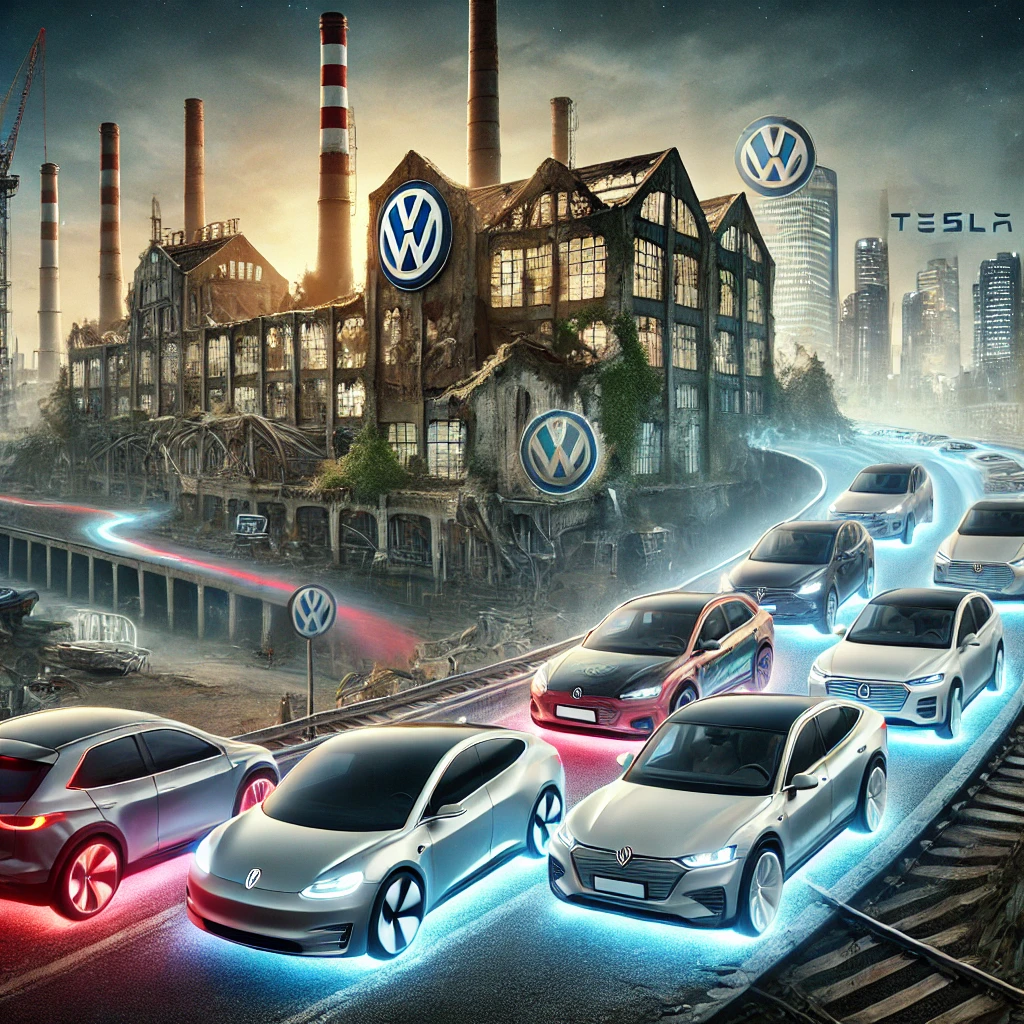The German auto industry has long been a symbol of engineering excellence and industrial might. For decades, global automakers aspired to match the precision, quality, and innovation of Germany’s giants: BMW, Volkswagen, and Mercedes-Benz. These brands dominated roads worldwide, their vehicles synonymous with luxury and reliability. Yet, as the world shifts gears into a new era of electrification and technological disruption, Germany’s automotive empire is facing an existential crisis.
Caught off guard by rapid change and paralyzed by decades of overconfidence, the German auto industry is now scrambling to stay relevant. But the truth is stark—time may already have run out.
Falling Behind the Curve
1. Late to Embrace EVs
While Tesla was reshaping the automotive landscape with sleek, efficient electric vehicles (EVs), German automakers were busy doubling down on their internal combustion engine (ICE) dominance. They dismissed EVs as a niche market, underestimating the rapid shift in consumer preferences and global regulations. By the time Volkswagen introduced its ID series and BMW launched the i4, Tesla had already set the standard for the EV market, with Chinese automakers like BYD and NIO close on its heels.
The result? German brands are now playing catch-up in a game where they’re no longer the innovators but the followers. Their EV offerings struggle to compete on price, range, or technology, leaving them vulnerable in a rapidly evolving market.
2. Losing the Chinese Market
China, the world’s largest automotive market, was once a stronghold for German automakers. Today, that market is slipping away. Chinese EV manufacturers have surged ahead, leveraging government support, advanced technology, and competitive pricing. Brands like BYD, NIO, and Xpeng dominate the local market and are aggressively expanding into Europe, directly challenging German automakers on their home turf.
Even premium segments, once the domain of BMW and Mercedes-Benz, are being eroded by Chinese luxury EVs like the NIO ET7 and Zeekr 001. German automakers, reliant on ICE sales, are losing relevance in a market that has embraced electrification at an unprecedented pace.
3. Stellantis: Struggling but Still a Threat
Stellantis, the multinational giant formed by the merger of Fiat Chrysler and PSA Group, faces its own set of challenges, including a 27% drop in third-quarter revenue and a 20% decrease in sales volumes in 2024. Despite these struggles, Stellantis remains a formidable competitor. The group is actively addressing its issues by reducing bloated inventories and launching new EV models, which pose a direct threat to German automakers. Brands like Peugeot, Citroën, and Fiat are offering affordable EVs that directly compete with VW’s Seat and Skoda. Meanwhile, Opel, a Stellantis brand, is repositioning itself as an EV-first manufacturer, further crowding an already competitive market. This dual strategy of recalibration and aggressive EV expansion places Stellantis in a unique position to capitalize on the challenges facing Germany’s auto giants.
A Cascade of Challenges
The German auto industry’s woes are not limited to EV adoption. A broader set of challenges has compounded its decline:
1. ICE Demand is Collapsing
Global demand for internal combustion engine vehicles is declining far faster than anticipated. With countries announcing ICE bans and consumers increasingly opting for EVs, the traditional cash cows of German automakers are becoming obsolete. Factories built for mass ICE production now stand as liabilities rather than assets.
2. The Tech Gap
Tesla’s dominance isn’t just about batteries; it’s about software. From autonomous driving to over-the-air updates, Tesla has redefined what consumers expect from their vehicles. Chinese automakers, with their focus on technology-driven features, are also leading the charge. German automakers, by contrast, lag significantly in software innovation, a critical factor in the modern automotive market.
3. Structural Inertia
Legacy systems that once powered German dominance are now their Achilles’ heel. Decades of investment in ICE manufacturing, sprawling supply chains, and rigid labor agreements make it nearly impossible for German automakers to pivot quickly. Meanwhile, Tesla and Chinese disruptors, unburdened by legacy costs, are innovating at a pace German brands cannot match.
4. Consumer Preferences Have Shifted
Younger, tech-savvy buyers prioritize sustainability, connectivity, and affordability over traditional hallmarks of German engineering. German automakers’ reputations for mechanical precision no longer command the loyalty they once did. Tesla’s software-driven vehicles and Chinese brands’ affordability resonate far more with modern consumers.
Who Might Survive?
Not every German automaker will collapse, but even survival comes with diminished relevance. Here’s a brutally honest assessment:
- Volkswagen: With its scale and resources, VW has the best chance of staying afloat. However, it will likely remain a follower in the EV market rather than reclaiming its leadership position.
- BMW and Mercedes-Benz: These brands may survive as luxury niche players, but their mass-market dominance is over. Premium competition from NIO, Zeekr, and other Chinese luxury EVs will continue to erode their market share.
- Porsche: As part of VW, Porsche is well-positioned to thrive in the performance EV segment. Its strong brand and focus on high-margin, low-volume vehicles give it a clear path to profitability.
Brands like Opel, Audi, and VW’s budget lines (Seat, Skoda) face a far grimmer future, likely to be phased out or drastically restructured.
Stellantis, with its diversified portfolio and cost-efficient EV strategy, poses a further existential threat to these struggling German brands.
What Needs to Happen—But Probably Won’t
For the German auto industry to have a fighting chance, it must act boldly and decisively. Here’s what it would take:
- Go All-In on EVs: The ICE era is over. German automakers must stop clinging to it and focus all resources on building competitive EVs at scale.
- Partner with Innovators: Collaborations with battery and software leaders are essential to close the tech gap.
- Restructure Aggressively: This means factory closures, layoffs, and shedding legacy costs—painful but necessary steps to remain competitive.
- Target Affordability: German brands must develop EVs that compete with Chinese and Tesla offerings on price without compromising quality.
Even with these measures, the road ahead is uncertain. The industry’s structural and cultural inertia may make such bold moves impossible to execute in time.
The End of an Era
The German auto industry’s decline isn’t just a cautionary tale about corporate complacency—it’s a stark reminder of how quickly disruption can topple even the mightiest players. For decades, these automakers defined the global automotive landscape. Today, they risk becoming relics of a bygone era.
The future belongs to those who move fast, think differently, and embrace change. For German automakers, that future may have already passed them by.
Detailed Revenue Trends for German Automakers (2014–2024)
Here’s a comprehensive breakdown of revenue figures for major German automakers, including Audi, as well as Stellantis, covering the past decade and highlighting specific trends.
Volkswagen Group (VW)
- 2014: €202B
- 2015: €208B
- 2016: €215B
- 2017: €230B (Dieselgate begins impacting global sales)
- 2018: €240B
- 2019: €252B (pre-pandemic peak)
- 2020: €260B (mild recovery post-pandemic impact)
- 2021: €280B
- 2022: €300B (peak revenue year for ICE)
- 2023: €322B (inflated by price increases, despite shrinking ICE volumes)
- 2024 (Forecast): €310B (decline as ICE revenues contract further and EV profitability remains low)
Audi (Subsidiary of VW Group)
- 2014: €54B
- 2015: €58B
- 2016: €59B
- 2017: €60B (Dieselgate pressures emerge but Audi remains relatively stable)
- 2018: €61B
- 2019: €62B (peak revenue)
- 2020: €58B (pandemic affects sales globally)
- 2021: €59B
- 2022: €62B (marginal recovery driven by higher EV adoption)
- 2023: €61B
- 2024 (Forecast): €59B
BMW Group
- 2014: €80B
- 2015: €85B
- 2016: €90B (strong growth driven by global ICE sales)
- 2017: €92B
- 2018: €95B
- 2019: €97B (revenue stabilizes pre-pandemic)
- 2020: €93B (pandemic year decline)
- 2021: €96B
- 2022: €98B (marginal growth as EV models like the i4 gain traction)
- 2023: €97B (decline begins as ICE sales falter)
- 2024 (Forecast): €94B (further decline driven by reduced profitability in EVs and China market share loss)
Mercedes-Benz (Daimler Group)
- 2014: €85B
- 2015: €90B
- 2016: €95B (steady growth in premium ICE demand)
- 2017: €100B
- 2018: €102B
- 2019: €105B (peak ICE demand)
- 2020: €99B (pandemic downturn)
- 2021: €103B
- 2022: €108B (revenue peak as luxury EV models like EQS gain traction)
- 2023: €105B (decline begins with reduced margins in EVs)
- 2024 (Forecast): €100B (further drop driven by softening demand in China and Europe)
Stellantis (Includes Fiat, Peugeot, Opel)
- 2014: €165B
- 2015: €168B
- 2016: €170B (growth driven by European ICE sales)
- 2017: €172B
- 2018: €175B
- 2019: €178B
- 2020: €180B (mild recovery post-pandemic impact)
- 2021: €185B
- 2022: €190B (strong recovery driven by affordable EVs in Europe)
- 2023: €200B (peak revenue year as Stellantis scales EV production)
- 2024 (Forecast): €190B (decline driven by increased competition from Chinese brands and tightening profit margins in Europe)
Key Trends Across All Brands
- Peak Revenue Periods:
- Volkswagen peaked at €322B in 2023, largely due to pricing adjustments, while Stellantis hit its high of €200B in the same year.
- Audi (€62B), BMW (€98B), and Mercedes (€108B) peaked between 2019 and 2022 before revenue declines began.
- Post-Pandemic Recovery:
- All brands saw a rebound in revenues from 2020 to 2022 due to pent-up demand and price increases. However, the recovery masked underlying issues like falling ICE demand and increasing pressure from Tesla and Chinese brands.
- Ongoing Decline:
- 2024 forecasts show declining revenues across all brands due to collapsing ICE sales, low EV profitability, and shrinking market share in China and Europe.


